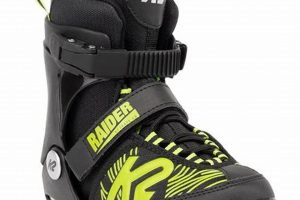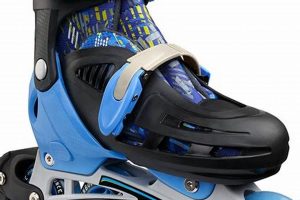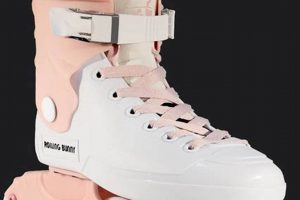These specialized sporting devices are designed for speed and efficiency on paved surfaces. Characterized by a low-cut boot for enhanced ankle mobility and a long frame to accommodate multiple wheels, they facilitate rapid acceleration and sustained high velocities. As an example, athletes in marathon skating competitions rely on this equipment to achieve peak performance.
The adoption of this equipment has significantly impacted the world of competitive skating, fostering advancements in technique and training methodologies. Their design allows for greater power transfer and reduced rolling resistance, enabling skaters to cover distances faster and more efficiently. Historically, these skates have evolved from recreational models to highly engineered pieces of athletic equipment, contributing to the sport’s growing popularity and record-breaking achievements.
The subsequent sections will delve into the specific components that contribute to the performance characteristics described, including frame materials, wheel composition, and bearing technology. Furthermore, an analysis of techniques used by skaters to maximize the potential of this equipment will be presented, along with considerations for maintenance and optimal use.
Optimizing Performance with Specialized Skating Equipment
The following guidelines are intended to enhance performance and longevity of specialized skating equipment. Adherence to these recommendations can contribute to improved efficiency and reduced risk of injury.
Tip 1: Frame Alignment Verification: Prior to each use, inspect the frame alignment. Misalignment can lead to uneven wear on the wheels and compromise stability at high speeds. Use an alignment tool to ensure proper wheel positioning.
Tip 2: Wheel Rotation Strategy: Implement a consistent wheel rotation schedule. The rear wheels typically experience greater wear due to the mechanics of the skating stride. Rotating wheels prolongs their lifespan and maintains consistent grip characteristics.
Tip 3: Bearing Maintenance Protocol: Regularly clean and lubricate bearings. Dirt and debris accumulation impede bearing performance, reducing skating efficiency. Use a specialized bearing cleaner and lubricant to maintain optimal function.
Tip 4: Boot Fastening System Integrity: Routinely check the closure system of the boot. Loose or damaged buckles, laces, or straps compromise foot support and increase the risk of ankle injury. Replace worn components immediately.
Tip 5: Surface Condition Awareness: Be mindful of surface conditions. Skating on abrasive or uneven surfaces accelerates wheel wear and increases the potential for falls. Choose smooth, well-maintained surfaces whenever possible.
Tip 6: Frame Material Inspection: Periodically examine the frame for signs of stress or damage. Cracks or bends in the frame can lead to catastrophic failure at high speeds. Replace damaged frames immediately.
Tip 7: Optimized Stride Mechanics: Refine skating technique to maximize efficiency. A long, powerful stride minimizes the energy expenditure required to maintain velocity. Consult with a skating coach for personalized instruction.
Consistent application of these principles will contribute to enhanced performance and a prolonged lifespan of the equipment. Neglecting these considerations may result in decreased efficiency, increased risk of injury, and accelerated wear of the equipment.
The subsequent section will address the historical development and emerging technologies related to this specialized equipment.
1. Aerodynamic Boot Design
The aerodynamic boot design of racing skates directly influences the skater’s speed and efficiency. Air resistance constitutes a significant impediment at high velocities; consequently, minimizing the frontal surface area and optimizing the boot’s shape reduces drag. This drag reduction allows the skater to maintain higher speeds with less energy expenditure. Specific design elements, such as a close-fitting profile and smooth, uninterrupted surfaces, are crucial for achieving optimal aerodynamic performance. For example, a leading manufacturer utilizes computational fluid dynamics (CFD) to refine boot shapes, resulting in measurable reductions in drag coefficients.
The materials employed in the boot’s construction also play a critical role. Lightweight, rigid materials contribute to improved aerodynamics by maintaining the boot’s shape under stress, preventing deformation that could increase drag. Furthermore, ventilation systems integrated into the boot design manage heat and moisture, enhancing comfort and preventing performance degradation due to overheating or perspiration build-up. Examples from professional skating demonstrate the impact of aerodynamic design; skaters using boots with optimized airflow and reduced frontal area consistently achieve faster times and improved endurance.
In summary, aerodynamic boot design is not merely an aesthetic consideration but a critical performance factor in competitive skating. The combination of streamlined shapes, advanced materials, and effective ventilation systems directly translates to increased speed, reduced energy consumption, and enhanced overall performance. Ongoing research and development in this area continue to push the boundaries of what is achievable in inline skating, highlighting the practical significance of understanding and optimizing aerodynamic principles.
2. Lightweight Frame Materials
The selection of lightweight frame materials is a paramount consideration in the design and performance of equipment designed for speed. These materials directly influence the overall weight, responsiveness, and energy transfer characteristics, factors crucial for competitive success.
- Carbon Fiber Composites
Carbon fiber composites represent a prevalent choice due to their exceptional strength-to-weight ratio. These materials exhibit high stiffness, enabling efficient transfer of energy from the skater’s push-off to forward motion. Their low density contributes to reduced overall weight, minimizing inertia and improving acceleration capabilities. In professional competitions, carbon fiber frames are frequently utilized, providing a noticeable advantage in sprint and endurance events.
- Aluminum Alloys
Aluminum alloys offer a balance of strength, weight, and cost-effectiveness. While generally heavier than carbon fiber composites, high-grade aluminum alloys provide adequate stiffness and durability for many skaters. These materials are commonly found in entry-level to mid-range equipment, offering a reliable and more affordable alternative. Examples include 7000 series aluminum, known for its high tensile strength and resistance to fatigue.
- Magnesium Alloys
Magnesium alloys present another option for reducing frame weight, offering a density even lower than aluminum. However, magnesium alloys typically exhibit lower stiffness and corrosion resistance compared to aluminum and carbon fiber. Consequently, they are less frequently used in high-performance equipment but may find application in specific frame components or niche applications where weight savings are paramount.
- Frame Length and Wheel Configuration
While not a material property, frame length and wheel configuration are intrinsically linked to frame material selection. Longer frames, designed to accommodate larger wheels, require stiffer and stronger materials to maintain stability and prevent flex. The combination of frame material and length directly influences the skater’s ability to maintain high speeds and execute precise maneuvers. Manufacturers must carefully balance these factors to optimize performance for specific skating styles and competition types.
The strategic application of these materials, factoring in frame geometry and intended use, is critical for achieving optimal performance. The evolution of lightweight frame materials continues to drive innovation in skating, enabling athletes to push the boundaries of speed and endurance. Understanding the properties and tradeoffs of each material allows skaters to make informed decisions regarding equipment selection, ultimately contributing to improved performance and competitive outcomes.
3. High-rebound wheel compounds
The efficiency of specialized skating equipment is inextricably linked to the properties of its wheels. Among these properties, the rebound characteristic of wheel compounds is a critical determinant of speed, control, and overall performance.
- Energy Return and Rolling Efficiency
High-rebound wheel compounds exhibit a superior capacity to return energy during each rotation. As the wheel deforms under load, the material stores kinetic energy and subsequently releases it as the wheel regains its shape. This minimizes energy loss due to hysteresis, improving rolling efficiency and reducing the skater’s effort to maintain speed. A skater utilizing wheels with a low rebound rate will expend considerably more energy to sustain a given velocity compared to a skater using high-rebound wheels.
- Durometer and Grip Characteristics
The durometer, a measure of a wheel’s hardness, often correlates with its rebound properties. Harder wheels generally exhibit higher rebound, offering lower rolling resistance on smooth surfaces. However, they may compromise grip, particularly on uneven or slippery surfaces. Conversely, softer wheels provide enhanced grip but typically exhibit lower rebound, increasing rolling resistance. The optimal durometer selection depends on the skating surface and the skater’s preference for speed versus control. For instance, a skater competing on a polished indoor track might opt for a harder wheel, while a skater navigating outdoor courses with varying surface conditions might prioritize a slightly softer compound.
- Material Composition and Molecular Structure
The molecular structure of the polyurethane used in wheel construction significantly impacts rebound performance. Specific formulations and additives can enhance the material’s elasticity and resistance to deformation, resulting in improved energy return. Furthermore, the manufacturing process, including curing and molding techniques, influences the final properties of the wheel compound. Leading manufacturers invest heavily in research and development to create proprietary compounds that maximize rebound while maintaining durability and wear resistance.
- Impact of Wheel Size and Profile
Wheel size and profile also contribute to the overall rebound characteristics. Larger wheels generally exhibit lower rolling resistance and higher rebound due to their increased contact patch and reduced deformation. A rounded wheel profile promotes smoother transitions and cornering, while a flatter profile maximizes contact area for enhanced grip. The combination of wheel size, profile, and compound significantly affects the skater’s ability to accelerate, maintain speed, and execute maneuvers with precision.
In conclusion, the interplay between wheel compound, durometer, material composition, and wheel geometry dictates the performance characteristics of this equipment. The selection of high-rebound wheels represents a critical optimization point for skaters seeking to maximize speed, efficiency, and control in competitive skating environments.
4. Precision bearing systems
The performance of skating equipment is significantly influenced by the quality and design of its bearing systems. These systems are integral to minimizing friction and maximizing the efficiency of wheel rotation, directly impacting speed and endurance.
- Bearing Components and Materials
Precision bearings typically consist of inner and outer races, rolling elements (balls or rollers), a retainer or cage, and seals or shields. High-grade materials, such as stainless steel or ceramic, are employed to reduce friction and withstand the demanding conditions of racing. For example, ceramic bearings offer superior hardness and heat resistance compared to steel bearings, resulting in smoother rotation and extended lifespan.
- ABEC Rating and Tolerances
The Annular Bearing Engineers’ Committee (ABEC) rating system defines the manufacturing tolerances of bearings. Higher ABEC ratings (e.g., ABEC-7, ABEC-9) indicate tighter tolerances and improved precision, translating to reduced friction and enhanced speed. However, higher ABEC ratings also typically correspond to increased cost. The selection of an appropriate ABEC rating depends on the skater’s skill level and the demands of the application.
- Lubrication and Maintenance
Proper lubrication is essential for maintaining bearing performance and longevity. Lubricants reduce friction, dissipate heat, and protect against corrosion. Regular cleaning and lubrication are crucial for removing contaminants and ensuring smooth operation. Different types of lubricants, such as oils and greases, offer varying levels of performance and durability. Skaters should select lubricants specifically designed for skating bearings and follow recommended maintenance procedures.
- Bearing Shields and Seals
Bearing shields and seals protect the internal components from dirt, debris, and moisture. Shields are typically non-contact and provide minimal protection, while seals offer more comprehensive protection but can increase friction. The choice between shields and seals depends on the skating environment. For example, skaters who frequently skate in wet or dusty conditions should opt for sealed bearings to prevent contamination and maintain performance.
In summary, precision bearing systems are a crucial component of high-performance skating equipment. The selection of appropriate materials, ABEC rating, lubrication, and shielding significantly impacts the efficiency, speed, and durability. Skaters seeking to maximize performance should invest in high-quality bearing systems and adhere to rigorous maintenance practices.
5. Effective power transfer
Effective power transfer is a critical determinant of speed and efficiency in inline racing. The skater’s ability to translate muscular force into forward motion is directly influenced by the design and materials of the equipment. Maximizing this transfer minimizes energy loss and optimizes performance.
- Boot-Frame Interface Rigidity
The connection between the boot and the frame must exhibit minimal flex to ensure efficient transmission of force. Flex at this interface dissipates energy, reducing the power delivered to the wheels. Stiff materials, such as carbon fiber, are commonly used in both the boot and frame construction to minimize energy loss. Inadequate rigidity leads to wasted energy and diminished speed.
- Frame Stiffness and Wheel Placement
The frame must maintain its shape under load to ensure consistent wheel contact with the skating surface. Frame stiffness, often achieved through strategic use of materials and structural design, prevents energy dissipation through frame deformation. Wheel placement relative to the skater’s foot influences the leverage and force distribution. Optimal wheel placement maximizes power transfer and improves stability.
- Skater Technique and Posture
While equipment design plays a crucial role, the skater’s technique and posture are equally important for effective power transfer. A proper skating stride involves a full extension of the leg and a strong push-off, maximizing the force applied to the wheels. Maintaining a low, aerodynamic posture reduces air resistance and allows for more efficient power transfer. Incorrect technique can negate the benefits of advanced equipment design.
- Wheel Durometer and Surface Contact
Wheel durometer affects the contact patch between the wheel and the skating surface. A harder wheel offers lower rolling resistance but may compromise grip, particularly on uneven surfaces. The optimal durometer balances rolling efficiency with adequate grip to ensure effective power transfer. Insufficient grip results in slippage and wasted energy. The skating surface also influences the optimal wheel durometer for maximizing power transfer.
The synergistic effect of these elements boot-frame interface, frame stiffness, skater technique, and wheel durometer determines the overall effectiveness of power transfer in inline racing. Optimizing each element contributes to enhanced speed, efficiency, and competitive performance.
Frequently Asked Questions About Inline Racing Skates
This section addresses common inquiries regarding specialized skating equipment, providing clarity on various aspects of their design, functionality, and maintenance.
Question 1: What distinguishes racing skates from recreational models?
Racing skates are engineered for speed and efficiency, featuring lower-cut boots for enhanced ankle mobility, longer frames for increased wheel capacity, and high-performance components designed to minimize friction and maximize power transfer. Recreational models prioritize comfort and stability over speed.
Question 2: How does frame length impact performance?
Longer frames provide increased stability at high speeds and accommodate larger wheels, which offer lower rolling resistance. However, longer frames can reduce maneuverability. Shorter frames offer greater agility but may sacrifice top-end speed. The optimal frame length depends on the skater’s style and the type of race.
Question 3: What role does wheel durometer play?
Wheel durometer, a measure of hardness, influences grip and rolling resistance. Harder wheels offer lower rolling resistance on smooth surfaces but may compromise grip on uneven surfaces. Softer wheels provide enhanced grip but increase rolling resistance. Selecting the appropriate durometer depends on the skating surface.
Question 4: How frequently should bearings be cleaned and lubricated?
Bearing maintenance frequency depends on usage and environmental conditions. Regular cleaning and lubrication, typically every 10 to 20 hours of skating, are essential for maintaining performance and longevity. Use specialized bearing cleaners and lubricants for optimal results.
Question 5: What is the significance of boot stiffness?
Boot stiffness directly influences power transfer. A stiffer boot provides a more direct connection between the skater’s foot and the frame, minimizing energy loss due to flex. Softer boots offer greater comfort but may compromise power transfer. Racing boots typically feature a rigid construction for maximum efficiency.
Question 6: Can components from different brands be interchanged?
Component compatibility varies depending on the specific design and standards. While some components may be interchangeable, it is generally recommended to use components from the same brand or ensure compatibility through careful measurement and verification. Incompatible components can compromise performance and safety.
In summary, proper selection, maintenance, and understanding of the various components are crucial for optimizing the performance of this specialized skating equipment.
The following section will address the historical development and emerging technologies in the realm of inline speed skating.
Conclusion
This exploration has illuminated the multifaceted aspects of inline racing skates, from their core components and performance optimization strategies to frequently asked questions and historical context. Key factors such as aerodynamic boot design, lightweight frame materials, high-rebound wheel compounds, and precision bearing systems contribute significantly to the overall speed and efficiency of this specialized equipment. Understanding these elements, along with proper maintenance and technique, is critical for maximizing performance in competitive skating.
The pursuit of improved speed and efficiency in inline racing continues to drive innovation in equipment design and materials science. Future advancements will likely focus on further reducing weight, minimizing friction, and optimizing power transfer. Continued research and development in this area hold the potential to redefine the limits of human performance in the sport of inline speed skating, demanding continued attention to the evolution of this high-performance equipment.




![Best Outdoor Inline Skates: Reviews & Guide [Year] How to Skateboard: A Beginner's Guide to Your First Board & Tricks Best Outdoor Inline Skates: Reviews & Guide [Year] | How to Skateboard: A Beginner's Guide to Your First Board & Tricks](https://cruzskateshop.com/wp-content/uploads/2025/10/th-951-300x200.jpg)


